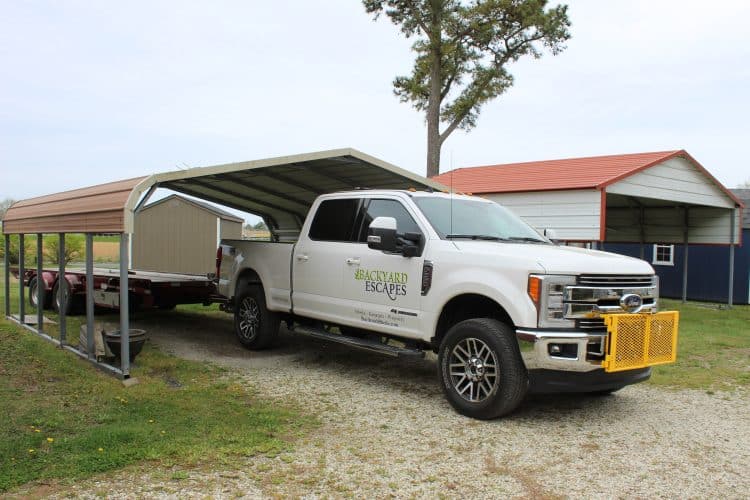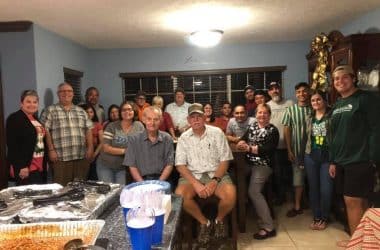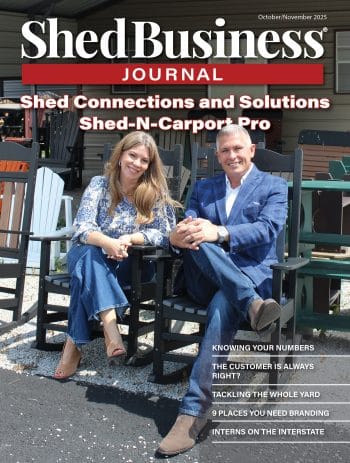
For shed companies, a variety of factors go into determining the best, and most profitable, way to move their products from Point A to Point B.
The size and makeup of the company, the footprint of their delivery reach, and the sizes of the sheds being hauled all play a role.
Going Local
Sam Fawcett, general manager of shed manufacturer and retailer Bitterroot Shedz in Stevensville, Montana, typically hires local drivers to ship his products to a network of in-house and contracted dealers. In the process, he’s able to more efficiently manage both schedule and cost.
“Our drivers are all contracted,” he says. “We have guys that haul primarily for us, but like any hauler, they’re going to haul where they can.”
Bitterroot Shedz delivers its product to a 300-mile radius and builds in transportation costs into its pricing structure. Additional fees are added for long hauls.
“It’s the way we’ve done it since day one,” Fawcett says. “We have a radius of free delivery, then outside that radius, there’s a mileage charge on top of that. We try to incorporate our deliveries into our pricing structure.”
Nevertheless, there have been challenges to his profitability over the years, with volatile fuel prices at the top of the list. According to the Bureau of Transportation Statistics, trucking rates are currently a mixed bag — while some types of trucking are experiencing increases, others are seeing decreases.
Drivers typically account for fuel fluctuations in their pricing, passing the additional cost directly to their shed builder customers. In extreme cases, Bitterroot Shedz will add a fuel surcharge but seeks to avoid any kneejerk reactions by meticulously managing their profit margin for every product and service, down to the nails and screws that go into each shed.
However, that’s not common practice among all shed builders.
“We try to have enough margin built into our pricing so we don’t have to change the price of a shed because fuel jumped a little bit,” Fawcett says. “You might have a tighter margin for a while, but it doesn’t mean you have to pass that on to the customer.”
Another challenge is a lack of available trucks, a particular problem during the pandemic demand boom. To build stability in its transportation system, Bitterroot Shedz maintains a network of local independent drivers whom they know, comprised of both primary drivers and several backups.
“As long as you give them enough advance notice, we can easily get them scheduled,” Fawcett says. “We try to keep everything as local as we can. We have high-quality drivers in the area and those guys deserve the work. They’ve done a good job for us; we stay contracted with them to give them consistent work.”
They rarely have issues finding drivers as a result, even during peak seasons.
“We know when we’ll need them, and we’ll plan accordingly,” he adds.
Under One Roof
Ryan Hurley, owner of Backyard Escapes, a retail shed company in Berlin, Maryland, gets most of his sheds from a group of Pennsylvania Amish families who use a network of independent shed haulers to deliver their products to him.
He also operates an e-commerce site and has the capacity to deliver nationwide.
Nonetheless, most products sold off Backyard Escapes’ lots are delivered within a 60- to 100-mile radius by Hurley or his two sons. His retail locations are situated on the eastern shores of Maryland, Delaware, and Virginia.
“We deliver the majority of the items with our own equipment,” Hurley says. “We try to keep a large inventory on our sites and when people buy something we’ll deliver it to them within a couple of days or a week.”
Hurley typically uses his own trucks to deliver the product, equipped with shorter trailers that enable him to easily maneuver into a customer’s yard. Hurley feels it’s a huge differentiator, as it affords him more control over the entire process.
That also helps with managing his profit margin.
“We’re not relying on someone else to complete the sale,” Hurley says. “They buy product from us and we’re the ones delivering it, so we’re able to make sure it’s done right and that the customer is happy.”
Transportation costs have played a significant role in determining the radius of Backyard Escape’s delivery area. They charge a base rate for a 30-mile radius. Outside of that, they’ll add additional fees.
“Many guys just starting out don’t have the means to buy a truck and a trailer, or to put all of their inventory on the lot,” he says. “We certainly didn’t start out that way, but little by little we grew.”
There are limitations to the approach, however, particularly when the sheds are on the larger side. That’s when Hurley uses independent truckers with larger equipment and longer-haul capabilities.
There are still plenty of drivers available, which gives Backyard Escapes room to negotiate terms. Those savings are then passed on to the customer.
“There are more haulers than there are buildings to be delivered,” he says, “so finding haulers isn’t an issue right now.”
Still, it’s usually a last resort.
“Using independent truckers can sometimes lead to delays, particularly if they’re unreliable,” he adds. “I like it when I can control the situation a little more.”
A New Dynamic
In the last few years, customers have begun to use shed structures for more than storing lawn equipment. They’re now choosing them for home offices, workout gyms, and “man caves.” As a result, the buildings are getting heavier, giving a competitive edge to those shed owners who have access to larger trucks.
In tandem with the shift, manufacturers are offering bigger and more capable trailers, enabling truckers to haul more product in a single trip — scheduling a trip with three buildings at a time, where before it might have only been one or two.
“That saves on fuel costs, time … everything,” Fawcett says. “We have drivers who can take 60 feet of building, so if we plan accordingly and know what we need for spacing and planning, we can really benefit from that.”
It has prompted Fawcett to expand his portfolio to include a line of fully manufactured turnkey homes.
“Whether it’s a single unit or multiple units that will be turned into a 3,000-square-foot home, we’ll be able to do that,” he adds. “They’re delivered in completed sections that are pieced together on location.”
Backyard Escapes’ Hurley is also mindful of changing customer needs, so he strives to stay up to date on the latest in transportation technologies.
“We’ve upgraded our trailers a couple of times since we started the company,” Hurley says. “I like to get a new trailer every five to seven years.
“I always look forward to going to trade shows to see the latest and greatest trailers. It’s like being in a candy store for me.”



